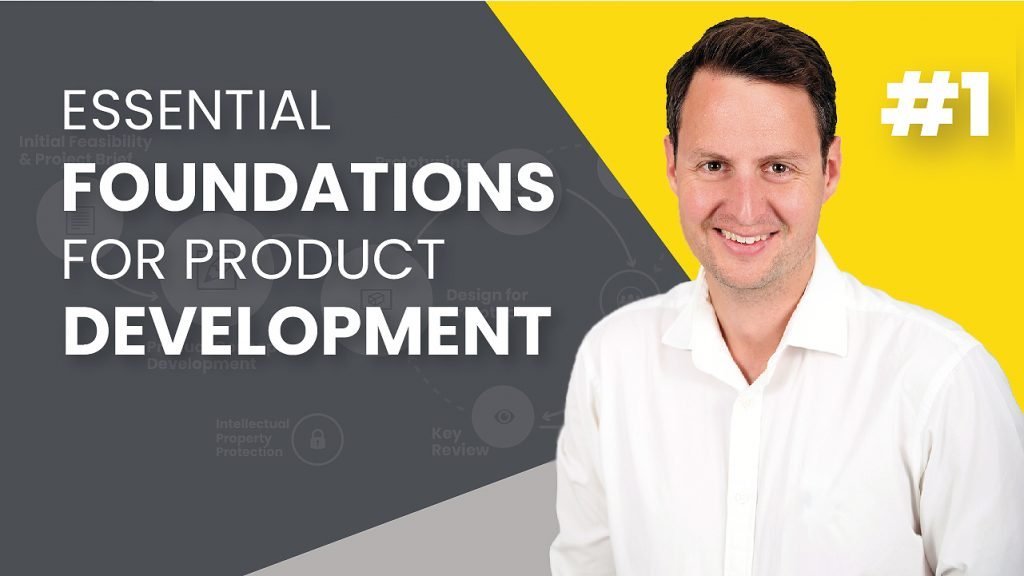Watch this video to understand how to develop a new product idea from scratch to manufactured product. Alternatively read the article below that includes the infographic used in the video.
Essential Foundations for product development
Essential foundations of Product Development
If you’re a start-up or you’re a small business you haven’t done product development before or you’re thinking about starting on a significant investment in terms of creating a new product idea, then this article is absolutely essential reading. This is because what it will do is ensure that you get the foundations of your project right, because if you don’t do that then you could end up wasting a huge amount of money.
So make sure you read right until the end because we’re going to cover off some key things that people often get wrong and if we get all this other stuff sorted out then you are much more likely to have a successful product at the end of it that makes you a really good return on your initial investment.

Let’s start with an overview we are in the top left corner of this infographic and we are looking at the early stage feasibility and how to set your project off in the right direction. After that there’s a whole lot of other activity that’s going to have to happen there’s going to be some sketch concept developments and styling work, market insight, prototyping, CAD development and finding a manufacturer. If all of that is on the wrong idea in the first place, or the wrong solution for your idea, then you’re going to waste a whole load of time and money.
Without further ado let’s get stuck into what that initial feasibility needs to involve. So there’s various elements of it and it really depends on what type of product idea you’re developing as to where your emphasis is going to lie, but with all product ideas market insights is critical because what you don’t want to do is design the product for yourself or for what you think your customers want or without your marketing team or marketing person. If you’re a start-up involved you’ve got to get the marketing message for the product nailed as part of the product development journey and I’ll give you example now of where we’ve worked on a project before and this has been a problem.

We worked on a novel shoe shining device and it was designed to give the best high-quality shine for a person’s shoes, but what the marketing message needed to be was “The fastest way to shine your shoes”. But this was not communicated at the beginning of the project and as such we weren’t designing something to be really fast, we were designing something to give that ultimate shine. If the product development and the marketing messaging was aligned from the outset, then the client would have had a much more quality product at the end which was what people wanted to purchase. That is a critical lesson to learn – what really matters needs to be set out from the beginning and then tested against through the product development journey.
Make sure that what you’re developing and the messages then that your marketing team are going to push around that product are resonating with your target market and if we can nail all of that, then you take out one of the biggest risks of product development which is that at the end of the day, no one buys your product.
Also, in these early days of the product being developed you’re going to need to look at your manufacturing feasibility and your technical feasibility and you may also want to do an innovation workshop. This can be done with your in-house team or bringing in some outside support to make sure the solutions you’re coming up with are the best that they can be.
Again, let me give you another example.
A client came to us with the problem how to make cyclists more visible to motorists, and his initial idea for that was a net of led lights you stretched over a rucksack. Now that’s one solution as it would have made the cyclist more visible – there’s nothing wrong with that. But we looked at a range of different options for it and eventually came up with this x structure.

It was a lot easier to get onto the rucksack it was a lot more cost effective in terms of manufacturing a lot more striking in terms of the aesthetic. It was just a different solution that gave an outcome that was right for the project. It gave the same outcome the cyclist is more visible but there are lots of other benefits for doing it this way and that’s why you really need to look at lots of different solutions in the innovation workshop stage. Otherwise you might have to pivot your project much further on in the development and it’s far more costly. If all you’re doing is changing initial sketches with a new idea then that is obviously quite quick and cheap to do but if you’ve got to change a whole prototype to suit a new idea then that can cost thousands, or even tens of thousands of pounds.
So the key is to get that assessed very early on and you might need to make basic physical models of a few different concepts and then go back to your target market and get some initial feedback from them before deciding on actually which technical solution you’re going to then develop in more detail. The commercials of your product idea are particularly critical at this stage as well you don’t want to spend tens of thousands of pounds developing something that is then too expensive for your target market or is going to cost you hundreds of thousands of pounds in unnecessary tooling to set up for production.
So again, that needs to be assessed at this early stage patent searching might be something else you need to look at as you don’t want to end up standing on other people’s toes and ending up with infringement issues. Once you’ve looked at all of these things then what you can really do is define a really tight project brief because you’ll know exactly what:
- your marketing message is,
- your target price point needs to be,
- technology you’re going to use to develop the right solution
Then with that project brief it’s the time where you can really start to invest in developing the idea knowing that you’re going to get a product out the end of it which is significantly de-risked compared with if you just cracked on with development without doing all these critical elements.
Now do make sure you watch my next video it’s all about the next phase of product development which is the concept work and the sketching and some initial styling this is the bit that gets really exciting that people really look forward to so do check that out now! Concept Development Video
